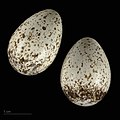| Greater hoopoe-lark | |
|---|---|
 | |
| Individual from Little Rann of Kutch | |
| Scientific classification | |
| Kingdom: | Animalia |
| Phylum: | Chordata |
| Class: | Aves |
| Order: | Passeriformes |
| Family: | Alaudidae |
| Genus: | Alaemon |
| Species: | A. alaudipes |
| Binomial name | |
| Alaemon alaudipes (Desfontaines, 1789) | |
| Subspecies | |
See text | |
 | |
| Resident range | |
| Synonyms | |
| |
The greater hoopoe-lark (Alaemon alaudipes) is a passerine bird which is a breeding resident of arid, desert and semi-desert regions from the Cape Verde Islands across much of northern Africa, through the Arabian Peninsula, Syria, Afghanistan, Pakistan and India. It was formerly known as the bifasciated lark and sometimes as the large desert lark. [2]




